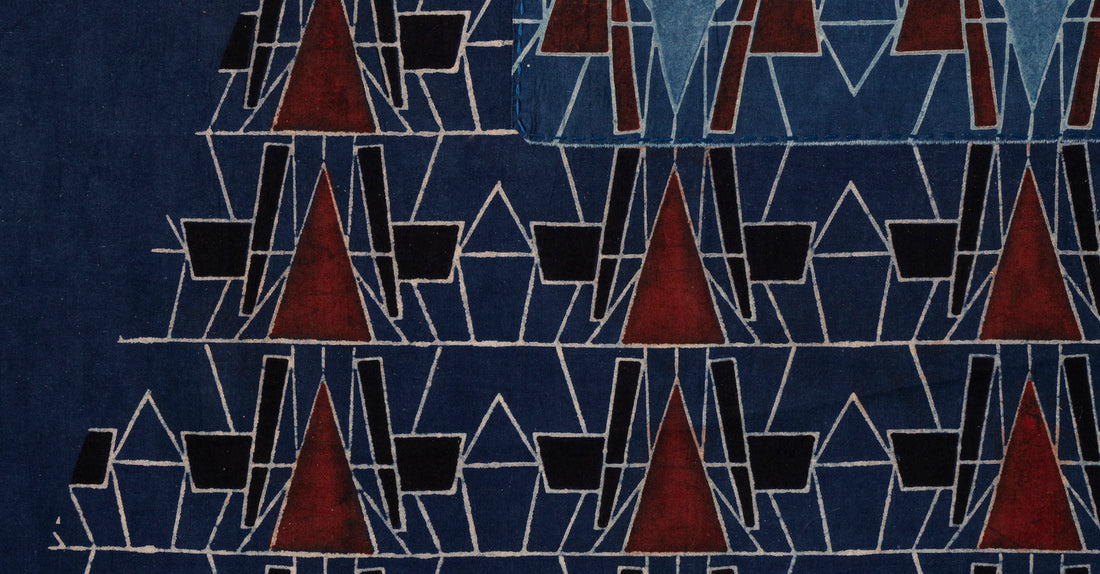
SWAPNAA TAMHANE: MOBILE PALACE
Image: Swapnaa Tamhane with Salemamad Khatri, and Mukesh, Pragnesh, and Avdhesh Prajapati, and Bhavesh Rajnikant. Assistance from Sine Kundargi-Girard and Lydia Haywood-Munn. Detail of panel from Mobile Palace, 2019–2021. Natural dyes, appliqué, and beading on cotton, each panel 39.4 in x 275.6 in (100 x 700 cm). Courtesy the artist © Royal Ontario Museum.
Artist Swapnaa Tamhane's current exhibition, Mobile Palace at the Royal Ontario Museum (ROM) in Toronto, brings together a series of layered textile compositions that reference the 'soft' tent palaces of the Ottomans and Mughals, but through the fresh lens of contemporary block print and embroidered textiles that have been created in collaboration with artists and textile practitioners in Gujarat.

Image: Swapnaa Tamhane: Mobile Palace at Royal Ontario Museum
There is a gathering of many hands in the exhibition. Tamhane conceptualised each piece, came up with the overall design, and applied embroidery and appliqué. She collaborated with artists from the region of Kutch in western India, long known for printed and painted cottons exported around the world. Mukesh Prajapati, his sons Pragnesh and Avdhesh, and nephew Bhavesh Rajnikant carved the wooden printing blocks, discerning how to translate Tamhane’s designs into functional three-dimensional form. Salemamad Khatri used the blocks for printing the fabric panels according to Tamhane’s arrangements and at his own discretion. Image: Swapnaa Tamhane, with Salemamad Khatri, and Mukesh, Pragnesh, and Avdhesh Prajapati, and Bhavesh Rajnikant. Assistance from Sine Kundargi-Girard and Lydia Haywood-Munn. Detail of panel from Mobile Palace, 2019–2021. Natural dyes, appliqué, and beading on cotton, each panel 39.4 in x 275.6 in (100 x 700 cm). Courtesy the artist © Royal Ontario Museum.
Image: Swapnaa Tamhane, with Salemamad Khatri, and Mukesh, Pragnesh, and Avdhesh Prajapati, and Bhavesh Rajnikant. Assistance from Sine Kundargi-Girard and Lydia Haywood-Munn. Detail of panel from Mobile Palace, 2019–2021. Natural dyes, appliqué, and beading on cotton, each panel 39.4 in x 275.6 in (100 x 700 cm). Courtesy the artist © Royal Ontario Museum.
The embroidered circular mirrorwork by the women from the Qasab collective glinting on some of the cotton panels followed Tamhane’s colour and placement choices and their own technique. Beyond these main contributors, there are other hands: those who picked the cotton, those who worked the machines in the cotton mills, those who made the dyes from vegetable and mineral sources used in the printing, those who did the beading.
Image: Swapnaa Tamhane, with Salemamad Khatri, and Mukesh, Pragnesh, and Avdhesh Prajapati, and Bhavesh Rajnikant. Assistance from Sine Kundargi-Girard and Lydia Haywood-Munn. Detail of panel from Mobile Palace, 2019–2021. Natural dyes, appliqué, and beading on cotton, each panel 39.4 in x 275.6 in (100 x 700 cm). Courtesy the artist © Royal Ontario Museum.
All the works in the exhibition draw on India’s long history of cotton - as a luxury fabric desired by the world and as a political tool of anti-colonial resistance. Beginning in the 18th century, European imperial powers took control over the trade and manufacture of India’s cotton, moving production to industrial textile mills abroad. British colonisation created an environment in which people in India were coerced to buy cheaper, lesser-quality, foreign-made cotton products. In early-twentieth-century India, the anti-colonial Swadeshi movement mobilised around spinning and wearing cottons from India. Indian-owned textile mills paved the way towards self-reliance and self-governance. Image: Swapnaa Tamhane: Mobile Palace at Royal Ontario Museum
Image: Swapnaa Tamhane: Mobile Palace at Royal Ontario Museum
The textile installations in the exhibition draw from a history of design in India. On the one hand they draw from eighteenth-century tent complexes from the South Asian and Islamic world, which created spaces transformed through fabric, colour, and light. Often referred to as "mobile palaces," they were used by royalty for leisure activities, diplomatic meetings, and military missions and allowed for an ease of movement around the kingdom.
On the other hand, the motifs on the textile installations are drawn from India’s modernist architecture, seen today as symbols of self- governance, progress, and modernity. In the decade after the end of British colonialism, India invested in building for a new nation using the latest principles of modernist design, which emphasised function, simplicity, and rationality through geometric forms, strong horizontal and vertical lines, and reinforced concrete. Tamhane was especially drawn to the Ahmedabad Textile Mill Owners' Association building (ATMA House), designed by Swiss-French architect Le Corbusier and completed in 1954.
Mobile Palace is on until 1 August 2022 at Royal Ontario Museum.
